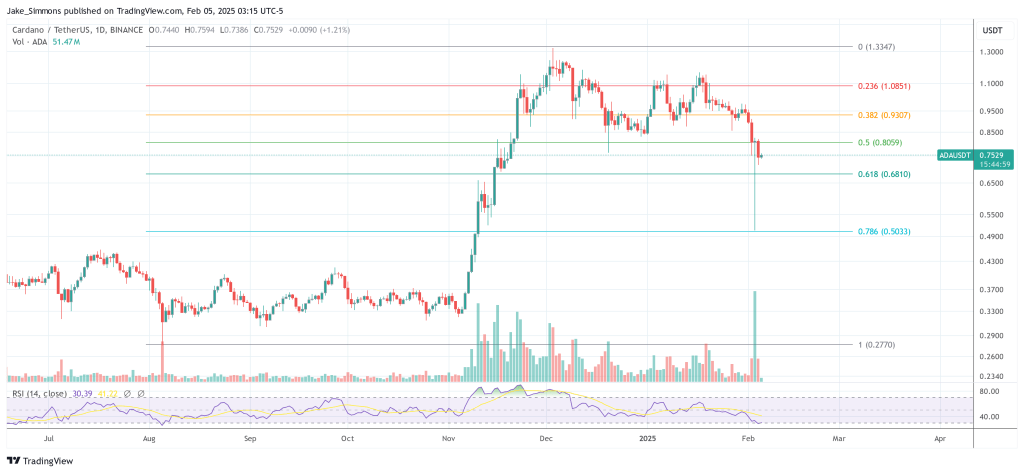In a livestream on February 4, 2025, Charles Hoskinson, founder of Cardano and CEO of Input Output Global (IOG), delivered a stark rebuke of Wyoming’s plan to develop a state-backed stablecoin. Hoskinson alleges that “freeze and seize” requirements—enabled by cryptographic tools to prevent or reverse transactions—were never openly disclosed in a proper product requirements document (PRD), effectively excluding Cardano and other major blockchain platforms from contention.
Cardano Founder Slams Wyoming’s Stablecoin As CBDC
Hoskinson’s remarks focus on the absence of transparency in Wyoming’s procurement process. According to him, the state failed to publish or share a detailed PRD that outlines key must-have features, such as the ability to freeze or seize tokens under certain legal or regulatory conditions. He says that this omission not only prevents fair competition but also poses risks to user privacy and broader blockchain adoption.
“We were told it would be an open process and we would know ahead of time what the product requirements would be,” Hoskinson says in the video. “Instead, they hid the PRD… and decided to qualify people themselves.”
He contends that Wyoming’s selection criteria were only disclosed after the fact, at which point the state allegedly gave less than five days for companies to prove they could meet the freeze-and-seize requirement. The Cardano ecosystem, he argues, could have implemented such a feature in approximately two weeks if it had been explicitly included in the PRD from the outset.
To highlight Cardano’s capabilities, Hoskinson contrasts fully programmable blockchains like Cardano and Ethereum with so-called “fixed-function” ledgers, including XRP. Programmable chains allow developers to build new features directly into smart contracts, meaning a freeze-and-seize capability can be added if required.
“On Cardano or Ethereum, if there’s something the protocol doesn’t support natively, you write a smart contract,” he explains. “So, if we had known freeze-and-seize was a Hardline product requirement, we could have simply written a contract to satisfy it.”
Hoskinson points to what he calls a mischaracterization by officials overseeing Wyoming’s stablecoin project, who had stated that Cardano did not meet this criterion without clarifying the short timeline or undisclosed requirements.
Throughout the video, Hoskinson implies that the process may have been orchestrated to favor a particular blockchain solution, suggesting that one of the decision-makers previously worked with the platform being singled out for the project. He underscores that no open bidding or public discussion took place on the critical features of the stablecoin.
Hoskinson also critiques the idea that Wyoming’s stablecoin would be functionally similar to a central bank digital currency (CBDC) because of its freeze-and-seize feature and transparent ledger, warning that this undermines financial privacy. In his view, this architecture gives authorities—or even third parties—the power to monitor all transactions and freeze funds at will.
“If you hold Wyoming stablecoin, know that everything you buy is monitored and tracked,” Hoskinson says. “At any given time, civil asset forfeiture… they can just seize it.” He questions the logic of investing state resources to build a product that, in his estimation, competes head-on with more established players—such as Tether or Circle—which have far larger budgets and market share.
In his remarks, Hoskinson underscores the economic challenges Wyoming’s stablecoin could face, citing a modest $5.8 million budget and a rapidly shifting regulatory environment. He argues that established stablecoin issuers generate billions in revenue and can pivot quickly to acquire or adapt to new regulations, leaving little room for a nascent state-backed project to gain market traction.
“Tether made $13 billion last year. Circle made basically the same,” he notes, pointing out the intense competition. “You have a $5.8 million budget… and at the end of the day, you’re sitting on a CBDC in Wyoming.”
He further questions why the state would not simply “white label” an existing stablecoin infrastructure rather than build from scratch, noting that negotiating a share of Treasury bill revenue or interest payments could theoretically benefit Wyoming without incurring large development costs.
Hoskinson, who lives in Wheatland, Wyoming, frames his criticism as a defense of local residents. He argues that public funds are being jeopardized in a venture that may fail to deliver a meaningful benefit to the state’s taxpayers. In his view, had the PRD been openly available—particularly the freeze-and-seize requirement—Cardano, among other platforms, would have submitted a bid more aligned with the state’s purported goals.
“They don’t deserve that,” he says of Wyoming’s workforce. “This is not how procurement works… not how anybody should operate.” He calls on officials, including state legislators, to scrutinize the project more rigorously, emphasizing the need for robust debate about whether the stablecoin, as presently structured, aligns with Wyoming’s pro-innovation image or inadvertently creates a centralized digital currency under federal oversight.
At press time, Cardano traded at $0.75.

Featured image from YouTube, chart from TradingView.com


